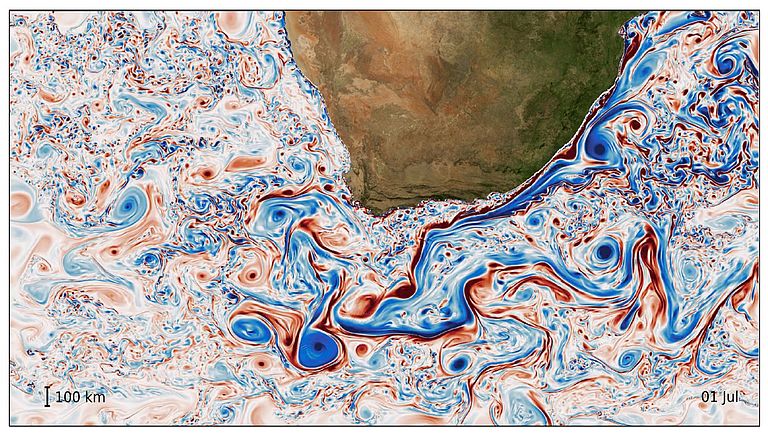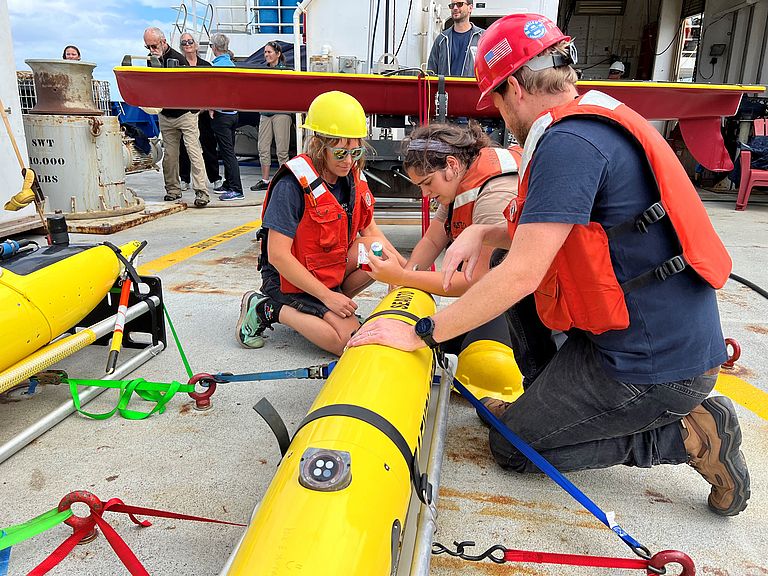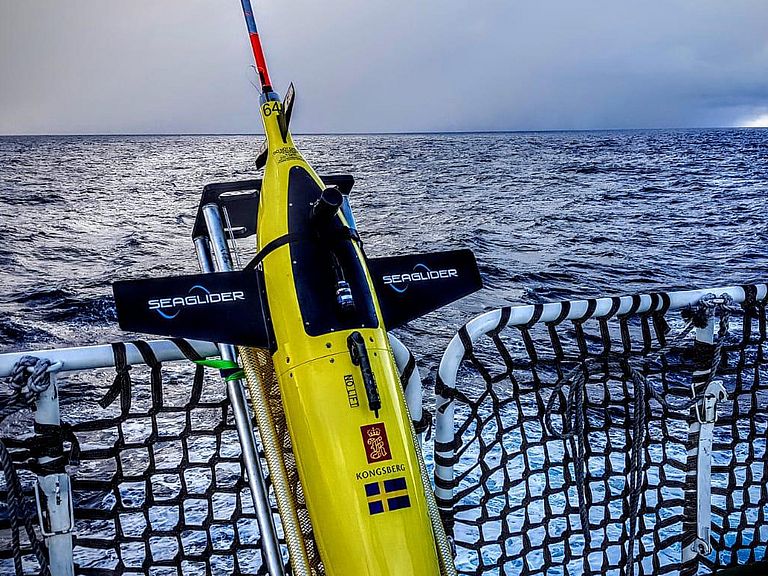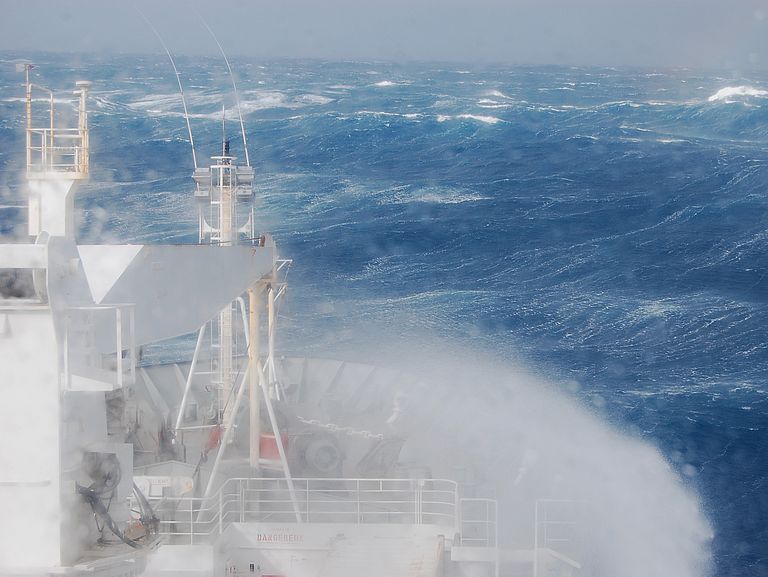WHIRLS: Small ocean swirls with large impacts on climate and marine life
International research team receives ERC Synergy Grant for interdisciplinary project
Heat and carbon are the primary factors influencing regional and global climate: The ocean absorbs huge amounts of heat, limiting the effects of global warming. When it releases heat to the atmosphere, the climate becomes warmer and wetter, and vice versa. Carbon that enters the ocean is distributed by ocean currents and taken up by phytoplankton. These tiny plants form the base of the marine food web and are key to marine biodiversity. Also, carbon stored in the ocean is removed from the atmosphere for hundreds of years, which also helps to mitigate climate change.
The exchange of heat and carbon between the ocean and the atmosphere, as well as their distribution within the ocean, is driven by larger currents and smaller eddies – and by even smaller circulation features, termed “whirls”. The WHIRLS project, funded by one of the European Research Council’s (ERC) prestigious Synergy Grants, will investigate these fine-scale processes. To this end, Professor Dr. Arne Biastoch from GEOMAR Helmholtz Centre for Ocean Research Kiel, Germany, Professor Dr. Sabrina Speich from the Ecole Normale Supérieure of Paris, France, Professor Dr. Sebastiaan Swart from the University of Gothenburg, Sweden, and Professor Dr. Sarah Fawcett from the University of Cape Town, South Africa, will implement a synergistic and interdisciplinary approach. WHILRS will be funded at the level of almost 12 million Euros over six years.
“WHIRLS is basically about fine-scale processes having large-scale impacts”, summarises Professor Dr. Arne Biastoch, ocean modeller at GEOMAR and coordinator of the new ERC-funded project. “Whirls refer to processes on scales of less than 100 kilometres. This might still sound large, but such patterns are small in the context of the global ocean, and are currently poorly resolved in ocean observations and climate models.”
The project will employ the latest observational capabilities, from ship-based measurements to autonomous instruments and satellites. It will move from a two-dimensional perspective to a three-dimensional representation of all relevant physical processes, resolved at time scales from days to seasons. WHIRLS will observe, model and track the interactions among the atmosphere, surface ocean and the ocean interior, and will investigate vertical mixing and the pathways of heat, nutrients and carbon within the ocean.
The collected data will be used to design and verify high-resolution models and to enable them to address fine-scale dynamics and their effects – responding to the urgent imperative to represent processes at the scale of kilometres in our Earth system models. The model results will improve climate predictions and projections of . WHIRLS contributes to the United Nations Decade of the Ocean Science for Sustainable Development and helps to address European and international scientific priorities.
The research will focus on the world’s most energetic region, the Agulhas Current System around South Africa. “The Agulhas system is not only unique in terms of its vigorous circulation, intense air-sea heat and carbon uptake and the particularly high productivity and diversity of its marine ecosystem”, explains Professor Dr. Sarah Fawcett, biogeochemical Oceanographer at the University of Cape Town. “It also plays a key role in the global ocean circulation and strongly influences regional and global climate.”
“GEOMAR is proud to coordinate WHIRLS as another project funded by an ERC Synergy Grant, and thus contribute to a better understanding of future changes in the ocean and the climate system. The funding underlines our leading role in cutting-edge research and recognises Arne Biastoch’s internationally renowned expertise in ocean and climate modelling,” says GEOMAR Director Professor Dr. Katja Matthes. “I am particularly pleased about the international cooperation that involves experts from four different countries on two continents. This impressively underlines the internationality of GEOMAR research. “Congratulations to the four principal investigators.”
Background: European Research Council (ERC) Grants
The European Research Council (ERC), set up by the European Union in 2007, is the premier European funding organisation for excellent frontier research. It funds creative researchers of any nationality and age, to run projects based across Europe. The ERC offers four core grant schemes: Starting Grants (for scientists having gotten their doctoral degrees recently), Consolidator Grants (scientists in the intermediate stage of their career), Advanced Grants (for senior scientists) and Synergy Grants (for projects which require combining the expertise of multiple scientists from different fields). Synergy Grants support cooperation of principal investigators to jointly address ambitious research problems that could not be addressed by the individual principal investigators and their teams working alone. The projects enable substantial advances at the frontiers of knowledge, stemming for example from the cross-fertilisation of scientific fields, from new productive lines of enquiry, or new methods and techniques, including unconventional approaches and investigations at the interface between established disciplines. Selected out of 395 proposals, 37 projects from 135 researchers from 114 institutions in 19 countries have now been granted funding through Synergy Grants.
Graphic: Zooming into the study region: Left: The global ocean mesoscale (10-100 kilometres) dynamics captured by a global model, Credit: MIT/JPL and NASA/Goddard Space Flight Center Scientific Visualization Studio. Centre: Actual modelling capabilities that simulate finer scales (submeso scale: 1-10 kilometres), Credit: Franziska Schwarzkopf, Arne Biastoch, GEOMAR. Right: Scales as observed from satellite shaping the surface phytoplankton distribution, Credit: NASA.

Mesoscale and submesoscale currents in the ocean south of Africa. A zoom into snapshots of surface normalised relative vorticity (a measure of rotation and turbulence) from a 1/60° of horizontal resolution numerical simulation. Graphic: Arne Biastoch, Franziska Schwarzkopf, GEOMAR

Phytoplankton blooms observed by the Aqua MODIS and Landsat 8 OLI satellites on July 23, 2018. Credit: NASA

An underwater robotic glider is being prepared for deployment in the Agulhas Current system. Photo: Johan Edholm, University of Gothenburg

Underwater robotic gliders can be used for missions of six two twelve months. They are able to dive to depths of 1000 metres to measure key parameters such as ocean currents, temperature, salinity, chlorophyll and oxygen. Photo: Marcel du Plessis, University of Gothenburg

The French research vessel MARION DUFRESNE II operating in the ocean southwest of Africa during a research cruise led by Professor Dr. Sabrina Speich. Photo: Sabrina Speich, LMD and ENS.


